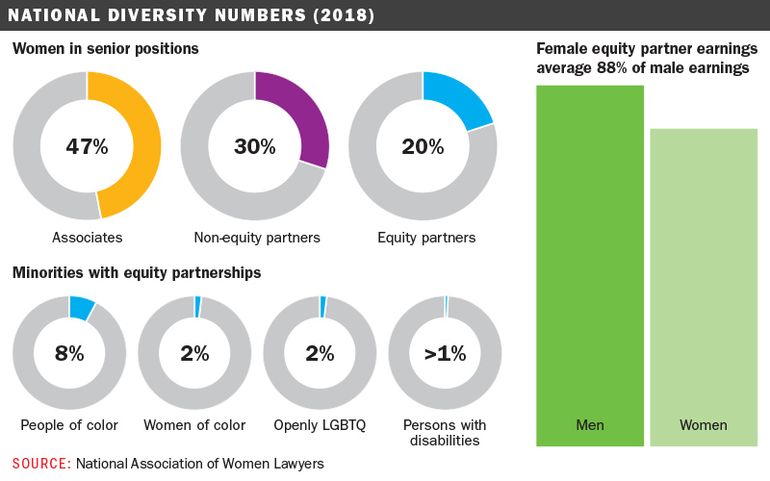Processing Your Payment
Please do not leave this page until complete. This can take a few moments.
Women have a growing presence in law firms, but lag behind men in leadership roles and pay
Gender equity, and diversity and inclusion in general, are on the minds of leaders in Maine's legal industry.
Women make up more than half of the graduates from the University of Maine School of Law. Women are coming into the profession in droves.
For over a decade, half of all law students nationwide have been women. Law firms have recruited women as entry-level associates in similar proportion, according to the National Association of Women Lawyers.
But while women have a growing presence in law firms, the number of women drops off as they rise in the ranks. And their compensation drops. According to the trade association, woman equity partners earn 88% of what their male counterparts make.
Nationally and in Maine, firms are looking to even the playing field by establishing programs, like diversity training, bias reduction, mentoring programs and family-friendly policies, designed to make it possible for diverse populations to stay in the profession and advance equitably.
Diversity task force
Trailblazing women have been role models in the profession since the 1940s, says Maine Law Dean Danielle Conway.
“While the numbers were slight at that time, the fact that women were trailblazers in the law, and attempted to integrate within the large legal community, gave their successors an opportunity to see themselves in this profession,” she says.
Verrill Dana, headquartered in Portland, hired its first female attorneys in the 1970s.
“It's hard to say why the leaders at that time were of the mindset to be inclusive, but it certainly has been important to the success of the firm,” says Jacqueline Rider, partner and chair of the firm's diversity task force, established in 2012. “And certainly there's a lot of recent data that shows gender-diverse companies perform better.”
In 1992, Verrill Dana was the first major law firm in Maine to elect a woman as managing partner. In 1998, the number of female attorneys at Verrill Dana was close to 2017's national average. At the end of 2017, nearly 38% of its attorneys were women and 40% of the firm's equity partners were female, surpassing national averages for firms its size by approximately 3% and 20%, respectively. (The firm has 78 attorneys in Maine and 128 across all offices.) Women serve in elected and appointed management roles throughout the firm, including as chairs of practice groups and on management committees. In 2018, the numbers put Verrill Dana among the top 10 law firms in the country for gender equality for the second year a row, as scored by the National Law Journal.
Rider, who started there as a summer clerk in 1992, echoes Conway's role model observation.
“When I came here, there were already women who were successful and in leadership positions,” says Rider. “When women come here, they see how successful women have been. They see the numbers, so they can see themselves having a career here. I think the fact that much of the leadership is made up of women is helpful to that. And of course we've always taken seriously development opportunities, mentoring and sponsorship — and all of that is regardless of gender.”
Diversity task force activities include surveys to ensure the company is taking steps that include and value attorneys and staff, recommendations for associate mentoring and development, working with the firm's hiring committee and speaker programs on topics like unconscious bias. Attorneys are active in organizations that broaden professional opportunities for underrepresented members of the legal profession, including the Connecticut Asian Pacific American Bar Association, the Massachusetts LGBTQ Bar Association and the Asian American Lawyers Association of Massachusetts. Verrill Dana annually reviews pay and promotion parity to avoid unconscious bias. A new take on harassment training uses results of a firm-wide cultural awareness survey to inform a customized program aimed at fostering a respectful and inclusive workplace.
Verrill Dana recruits from law schools with diverse student populations and diversity pledges that mirror its own.
“We've been working for 15 years with various schools that have high-diversity student populations, trying to become more familiar to them and successfully attract students to our summer associate program in Maine,” says Michele Pattenaude, the HR director. “That's probably not unlike the approach taken years ago in attracting women to the firm.”
Female retention
Like other law firms its size, Bernstein Shur brings in about equal numbers of women and men at the entry level, says Joan Fortin, a shareholder and director of attorney recruiting.
“At the moment, exactly 50% of our associates are women,” Fortin says. “But the transition from associate to equity partner is where many women drop out and don't make it to that final step. So the overall ratio of men to women isn't the story. It's the ratio along each stage of the career path that is important.”
Retention was part of the thinking behind Bernstein Shur's recently revised parental leave policy. Highlights include 16 weeks of paid leave, eliminating the distinction between primary and secondary caregivers and between attorneys and staff, and time-flexibility. Benefiting both women and men eliminates gender-role stereotypes, which presume the mother is the primary caregiver. The firm will soon adopt a remote work policy, formalizing flexibility already in place for attorneys. Moving away from mandatory face time allows attorneys to remain in the loop for projects, promotions and higher income, Fortin adds.
Aiming for pay parity, she created a chart showing factors that went into offers to new attorney hires, so future new offers can be compared objectively against past offers.
“That was my rudimentary effort to make sure we were being consistent and that women were getting offers that were as good as offers that went to men,” she says. “I didn't do that because there was a problem. There just didn't appear to be a system.”
Additionally, new offers are based on appropriate salaries, rather than assuming candidates will negotiate up — since research shows women are less likely to negotiate salaries.
Continuing to evolve
Recruitment of female attorneys is actually the less complicated part of the equation, says David Barry, managing partner of Pierce Atwood in Portland.
“The more challenging piece is retention,” Barry says. “This is not specific to Pierce Atwood. It's endemic in the profession. The attrition level among women lawyers is considerably higher than it is among men. The demands and inflexibility of the profession underlie that, and it is a continuing challenge.”
In 1945, Pierce Atwood became the first major law firm in Maine to hire a female attorney, Sigrid Tompkins. In 1953, she became the first female partner at a Maine law firm. Today, women serve in leadership roles across the firm.
“I remember from my early days here, there was a sensitivity and awareness of the need to pay attention to gender equality issues and to provide a working environment where women would have strong opportunities,” says Barry, who has been with Pierce Atwood for 30 years. He and his predecessor as managing partner, Gloria Pinza, became partners in the firm around the same time. “Gloria spoke many times over the years about the value and the importance of the firm's flexibility, and awareness of the need for flexibility, in allowing her and other women to both pursue their careers in a successful way and also to have the ability to deal with other aspects and demands of their lives. So I think this has been a long-standing and ongoing awareness at the firm.”
Today, a third of Pierce Atwood's attorneys are women. The firm continues to work to achieve gender equality through hiring, says Barry.
Initiatives include flexible work schedules and generous paid parental leave policies, to help lawyers and their families balance the demands of professional and personal lives.
The firm is also a founding and continuing sponsor of the Olympia Snowe Women's Leadership Institute, a three-year program that prepares high school girls for future leadership roles in the Maine economy.
In 2006, the firm established a diversity and inclusion committee to develop initiatives to diversify its workforce and educate firm members on diversity.
Outcomes
It can be difficult to quantify correlations between the various programs and gender/diversity numbers, leaders agree. But, they also agree, discussions around gender and diversity are timely.
Says Barry, “It's certainly something the legal profession is spending time and focus on, because the challenges are real. You can have all of the policies you want, but that's not the complete answer. Equally important is the will and the effort needed to create a culture where diversity and gender equality are both valued and encouraged, as well as creating and maintaining an environment where everyone has an opportunity to succeed and flourish.”
















Comments